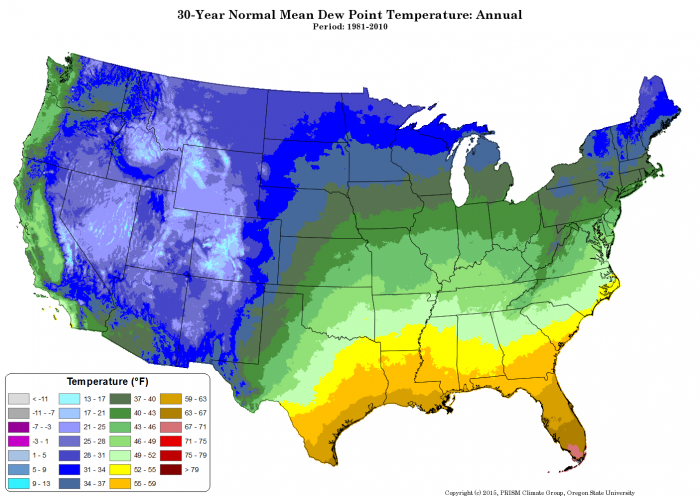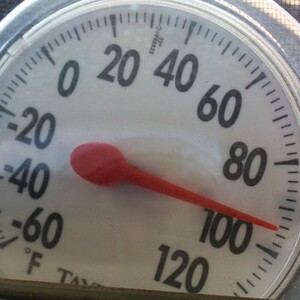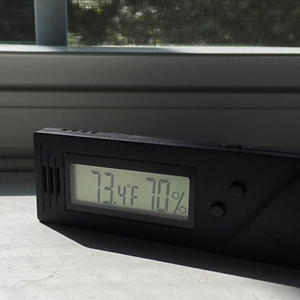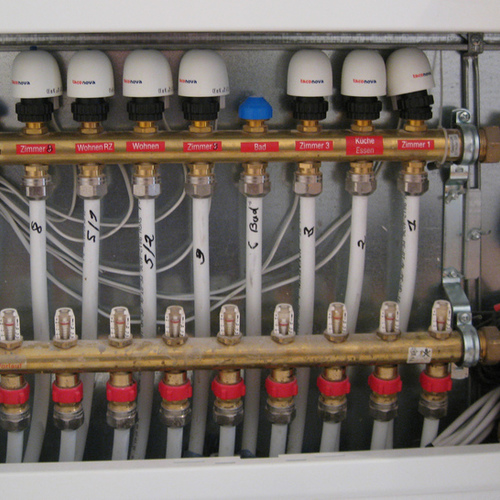
Our central air conditioning system has no trouble keeping the indoor temperature just where the thermostat is set. But the humidity indoors still seems way too high. It feels clammy and uncomfortable. Why?
An air conditioner both cools the air and makes it drier. Indoor air feels comfortable to most people when both the temperature and the relative humidity are in a certain range. Comfort is a relative term but for argument’s sake, suppose that in summer the goal is 74°F with a relative humidity of about 50%. When an air conditioner can keep up with temperature demands (what engineers call the “sensible load”) but not the humidity (the “latent load”), it’s not going to be very comfortable.
Heating contractors should be able to figure out both of these loads accurately by using Manual J, a set of calculations developed by the Air Conditioning Contractors of America. When sensible and latent loads are added together, the contractor gets the total cooling load. That’s expressed as a certain number of Btus of energy needed per hour. The contractor can choose equipment accordingly.
Sensible and latent loads vary quite a bit depending on where you live. The desert Southwest, for example, has vastly different conditions than the U.S. Southeast. One way of quantifying the difference is by looking at dew points—what the air temperature would have to be for the relative humidity to reach 100% and for moisture to begin to accumulate.

When the dew point is 70°, weather forecasters warn of “oppressive” conditions. When dew points fall into the 40s, you hear that conditions are “brisk” or “refreshing.” High dew points mean higher latent loads. Low dew points mean that an air conditioner will not be called upon to remove as much moisture from the air.
Why the problem occurs
To understand why indoor air can be cool but unpleasantly damp, think of how an air conditioner works. It uses what’s called the vapor compression cycle to cool down an evaporator coil. Air drawn over the coil by a fan will shed heat, and when the temperature of the coil is below the dew point, the air will unload some of the moisture it holds. The moisture condenses, drips off the coil, and eventually goes down the drain. The relative humidity falls, and when it gets down to 55% or so, most people will feel pretty good.
The problem is that air temperature may go down faster than relative humidity, and once the air temperature has reached the set point, the air conditioner turns itself off. Without it, there is no moisture removal. Life with a system like this is an unending cycle: quick bursts of cool air that lower temperature but don’t do much to lower relative humidity. It’s plenty cool, but it’s clammy.
The phenomenon is called short cycling, and it’s made worse by equipment that is too big for the space. There are many experts who believe AC contractors routinely install equipment that is oversized. They may or may not do the required Manual J calculations but even if they do, they keep their thumb on the scale to make sure they never get a call from an irate homeowner complaining the house is too hot.
Tight, well-insulated houses may exacerbate this imbalance because sensible loads tend to be lower while latent loads are still high. A whole-house ventilation system—a near necessity in very tight houses—can make indoor air more humid in the summer.
What you can do about it
An air conditioner is using some energy to lower temperature and some energy to remove moisture. Engineers call this proportion the sensible heat ratio (SHR), or the amount of energy used for the sensible load as a fraction of total energy consumption. A sensible heat ratio of 0.75 would be typical, meaning that 75% of total energy goes to cooling the air and the rest to removing moisture.
In a humid climate, it may be beneficial to choose equipment with a lower sensible heat ratio. Peter Yost, GBA’s technical director and a Vermont-based building consultant, says there are high-performance minisplit heat pumps with SHRs of less than 70%. On central systems, slowing down the fan speed makes the evaporator coil colder, and that will will help remove more moisture from the air. But as one expert explained, there are limits to this approach. Ken Gehring, the former head of Therma-Stor, said that over-cooling the AC’s evaporator coil can create problems of its own, such as condensation inside ductwork or a frozen coil.
David Butler, an Arizona-based consultant, suggests keeping as much moisture as possible out of the house in the first place, a strategy he calls source control. Make sure rain water is directed away from the house, use spot exhaust fans in the kitchen and bathroom, make sure dryer vents are working, and use a range hood that vents to the outside. All of those steps will help reduce indoor humidity and lower latent cooling loads.
Additionally, don’t buy equipment that’s too big for the space you’re trying to cool. As mentioned earlier, heating and cooling contractors have a reputation, deserved or not, for recommending AC systems that are way oversized. Hiring an independent consultant to specify the equipment is one way around this problem. Equipment that’s too big costs more to buy, uses more energy, and encourages short cycling.
Lastly, consider installing a dehumidifier. A whole-house unit will bring down interior relative humidity even when the AC equipment isn’t needed to lower indoor temperatures. This can be really helpful in the shoulder seasons of spring and fall, when there’s essentially no call for sensible heat removal but there are still substantial amounts of moisture in the air. Dehumidifiers are available in a wide variety of sizes—from units designed for houses of 5000 sq. ft. to small appliances that are mounted in a stud cavity in the wall—and they much less expensive to operate than central AC.
_________________________________________________________________________
–Scott Gibson is a contributing writer at Green Building Advisor and Fine Homebuilding magazine.
Weekly Newsletter
Get building science and energy efficiency advice, plus special offers, in your inbox.















29 Comments
Systems rarely operate at design load so it makes little sense to look at equipment SHR at rated output - forget about this number. Much more important is the required vs provided part-load absolute dehumidification rates (heat ratios just obscure the issue) . Some systems do well*, even when substantially over-sized and cycling. Many others (most inverter designs) do quite poorly**, even when perfectly sized and not cycling. So for latent performance, one should mostly ignore sizing and cycling - contrary to popular views, it's almost all about equipment design and CFM/ton at partial loads. But good luck finding this important info from manufacturer specs.
+1 on all but the driest climates will need a dehumidifier (see #13 below). Nothing else provides comfort when it's 70F and 90% RH outside. This occurs just about anywhere with rain.
*Fig 5-45
**Table 7
Is it possible, given a Manual J and a location, to get expected sensible and latent loads throughout the year (day by day?)
Or, put another way, can the peak/design loads produced by a Manual J be converted to that using some "derating"/"annualizing" formula (which would obviously be different for different locations, and produce different ratios of sensible/latent over time?)
Is there an equivalent of Heating degree days/Cooling degree days for expected latent loads? Can one use difference between design dewpoint and actual dewpoint in that way?
Happy to be pointed to reports/papers etc.
To get day-by-day info you need an energy model (or something like it) that uses hourly weather data, such as the TMY3 files from NREL. Manual J uses just the peak outdoor temp & humidity for a farily basic calculation of the heating+humidification & cooling+dehum. loads at one point in time. But, you can also look at more design day conditions - ASHRAE publishes 0.4%, 1%, and 2% dewpoint data along with the mean coincident dry bulb so you can look at what loads are and how equipment performs under muggy summer day conditions, not just the peak temperature day (the more typically used 0.4% and 1% dry bulb temp days).
Check out this methodology for sizing dehumidification written by Winkler & Booten at NREL.
https://www.nrel.gov/docs/fy16osti/66515.pdf
If you know Wrightsoft well and have access to ASHRAE weather data you can pretty much set up templates to run both cooling loads and dehumidification loads with a few modifications following the above paper. It would not be hard for Wrightsoft to add this feature to their software for users. I am sure the same could be done with Elite or other load-calc software.
One important issue with dehumidifiers is to understand the heat that they put out when they operate. The do an excellent job of removing moisture from the air, but they will often require the AC to run periodically to offset the heat they generate. Best option is to use a split dehumidifier with the condenser outside. I don't think this problem for bridge seasons in humid climates has been solved yet. In my house (https://www.greenbuildingadvisor.com/article/new-house-year-one-update). In high performance homes it is probably simpler to run the AC slightly lower when cooling isn't needed but the air is too humid. Dehumidifiers likely work better in buildings that aren't tight enough to control air (and moisture) movement effectively.
Anyone know what is done with a split dehumidifier to make the latent load higher? I mean at that point it's the same setup as an AC, so how do they tune for higher/lower latent removal? We're talking about systems like the SD12, right?
I think a system like that, with small ducts which also deliver filtered outdoor air, would combine really well with ceiling radiant cooling for houses in humid areas/periods.
Unless you get into variable reheating (like the Daikin Quaternity), then it's almost all about CFM/ton.
The SD-12 utilizes a passive heat exchanger to precool the air prior to the evaporator which makes it perform differently than an AC. The air enters the SD-12 through the heat exchanger (pre-cooling) goes through the evaporator and then back through the heat exchanger (post-heating) on its way out - basically the passive heat exchanger is moving some of the sensible heat around the evaporator. This precooling allows the evaporator to remove more latent heat as the air entering the evaporator is closer to dew point. The SD-12 has around a 0.4 SHR depending on conditions while an AC depending on how it is setup is usually between a SHR of 0.7 - 0.8.
Awesome, thanks David, that makes sense.
This comment might be considered a side note and somewhat off topic. But I know how easy it is for individuals to take information and apply it out of context without knowing it.. I've even done it myself at times when I didn't know better.
That dew point map shows the broad outlines of what the moisture content of air is in the USA throughout the year. But it doesn't seem to show what the article is emphasizing, mainly what the "seasonal" dew point is in summer. It seems to be taking the average dewpoint throughout the year. Perhaps I'm wrong but that's what the dew point numbers appear to me to be to be saying. They are just too low for the summer season.
This causes some anomalies. For instance, I know just from anecdotal evidence from people living in Maine on this forum that summer is humid there. But it doesn't show up that way on the map. Similarly, I grew up in the Central Valley in California and believe me it is hot, hot, hot, and dry, dry, dry there in summer. However in winter it is usually extremely humid with thick fog spread over the valley. What I think I'm seeing on the map is that when winter humidity is averaged with the summer dryness it appears that the summer might be more humid than it is. The marine region of the west coast also shows up as quite humid. Again, it's only partly true. It can be very humid in winter there but not so much in summer.
The only reason I bring this up is so individuals don't go off on a tangent at some later date by reading into the map data that actually isn't there. Sorry.
You captured well the same thought I had.
A per location histogram showing number of days per bucket of humidity range would be something useful to look for.
Would be useful to model the increased cost of running a dehumidifier with these high SEER but lousy part-load latent performance mini-splits.
Agreed. I'd be really interested to see the results of that; both in terms of energy consumption and carbon emissions of an extra unit.
On central systems, slowing down the fan speed makes the evaporator coil colder, and that will will help remove more moisture from the air. But as one expert explained, there are limits to this approach. Ken Gehring, the former head of Therma-Stor, said that over-cooling the AC’s evaporator coil can create problems of its own, such as condensation inside ductwork or a frozen coil.
Absolutely agree with Ken that there are limits on how much dehumidification you can get out of a central AC system. However, you can definitely wreck the latent (moisture removal) capacity of a central system with bad airflow settings. I have been dealing with many moisture problems where the furnace/air handler was dropped in, and the HVAC technician didn't adjust anything from factory settings. Result: 1000 CFM for a 2 ton system (500 CFM/ton), which means you will satisfy the thermostat, but not remove any moisture.
More discussion on the CFM per ton and moisture removal issue here:
How to Look at a House like a Building Scientist (Part 3: Temperature, Humidity, and HVAC Systems)
Temperature and humidity meters are useful tools for building investigations, specifically to measure HVAC equipment performance
https://www.greenbuildingadvisor.com/article/how-to-look-at-a-house-like-a-building-scientist-part-3-temperature-humidity-and-hvac-systems
Also, in terms of coil freeze-up risks: current DOE-sponsored research from the Home Innovation Research Laboratories (formerly NAHB Research) indicates acceptable performance and enhanced dehumidification down to 245 CFM/ton with modern equipment:
“Advanced HVAC Humidity Control Strategies for Hot-Humid Climates” https://www.energy.gov/sites/prod/files/2019/05/f62/bto-peer%E2%80%932019-hirl-advanced-hvac-humidity-control-hot-humid.pdf
Kohta - As you and Ken note, colder evap coils remove more moisture. But there are risks, i.e. coil freezing and moisture in the downstream duct work. I am musing that water carryover is an unintended consequence of an overly saturated coil, reducing the bypass factor and increasing velocity through the remaining free area of the fins. Could the theory of higher coil face velocity pull water off the fins and send it down stream into the blower and duct work in draw through air handlers? I have seen lots of water spots and microbial growth downstream, especially with poorly designed zoning systems where total airflow across the coil drops below 350 CFM per ton with one zone calling. Actually, I have never seen a properly designed zoning system or a unicorn either. Thoughts????
My car can run the A/C and heat at the same time. I'd like that to happen with my house so I would not have to go all Risinger on it. Sheesh. Wait, can I do that?
You can with two mini-splits supplying the same space.
Cool; mini splits are much cheaper!
Often in bridge season I run 1 split (eg in the LR) in heat mode and another (eg. in Kitchen) in dry mode. Both units are running at minimum power, about 250W together, and house stays dry. Much better than a dehumidifier.
"Peter Yost, GBA’s technical director and a Vermont-based building consultant, says there are high-performance minisplit heat pumps with SHRs of less than 70%." I don't see SHR on some mfr spec sheets. Where can I find these numbers? And should I even care? Because I thought the ability to modulate made all minisplits spectacularly good at controlling humidity.
> I thought the ability to modulate made all minisplits spectacularly good at controlling humidity.
Unfortunately, the exact opposite is typically true. Review response #1.
Why should modulation be worse at controlling humidity? People make and buy 2-stage central equipment for that very reason. Some minisplits even have special "dry" modes.
Who knows why they increase CFM/ton at low loads - probably to get a better SEER rating. Or possibly to avoid condensation.
Dry mode isn't standardized as to what it does. It may result in much lower capacity or loss of temperature control (becoming too cold). More data is needed.
The Daikin Quaternity might meet your "spectacular" description. It's expensive, but not so bad when compared to a lesser model + a high efficiency dehumidifier.
Not always true. I think you should condition your statements with "sometimes". Because the mitsubishi minisplit I have does a spectacular job at controlling humidity. Fills a five gallon pail once over two days, keeps it 50-55% RH at 72°F, three people in the house. Like anything, it's very conditional on the equipment, run time, what modulation level it runs at, etc.
I'm surprised no one has mentioned variable speed (inverter) air conditioners. We bought one that will run as low as 25% of capacity when paired with the proprietary thermostat. Better humidity control is one of their selling points.
Ours runs on the lowest stage most of the time and dehumidifies without over-cooling.
Jonathan, I believe a variable speed (inverter) air conditioner is the same thing as a minisplit.
Do you have a link to specifications to support their claim of better humidity control at 25% capacity?
I got curious about what kind of SHR one could realistically achieve under the circumstances mentioned in the article - 23C (about 74F) and 50% RH. I'll assume any air passing into the cooling coil is at that condition and set the air exit temperature to be just above freezing (1C) at 100% RH. Using enthalpy values given by the ASHRAE Fundamentals Handbook, I end up with a minimum SHR of 0.65.
So you if you had less than a 35% latent load, you'd be good. A greater latent load and you'd get too much cooling.
We only spec 3 stage, 5 stage, or true variable speed heat pumps in the hvac systems we design and we get incredible results.
Log in or create an account to post a comment.
Sign up Log in